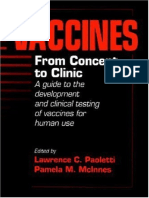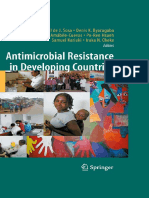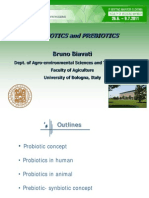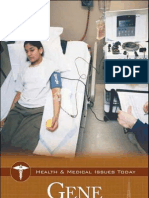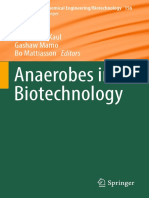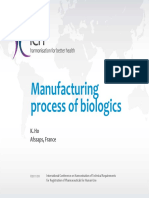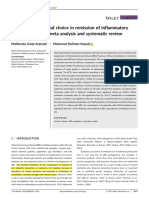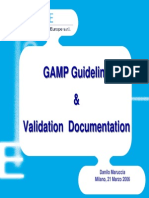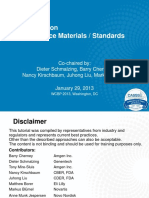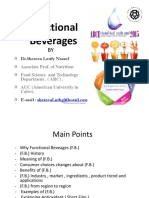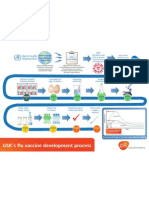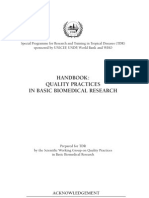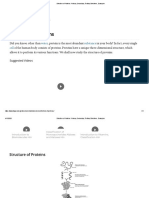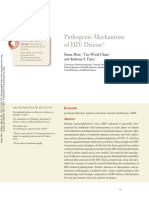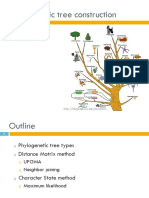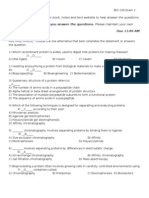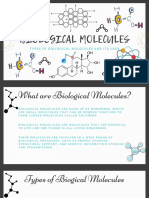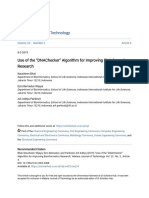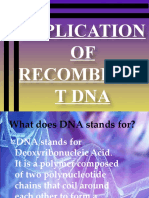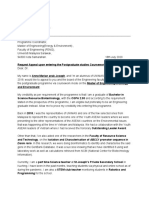Guidelines For The Evaluation of Probiotics in Food
Guidelines For The Evaluation of Probiotics in Food
Uploaded by
boyaccentCopyright:
Available Formats
Guidelines For The Evaluation of Probiotics in Food
Guidelines For The Evaluation of Probiotics in Food
Uploaded by
boyaccentOriginal Description:
Original Title
Copyright
Available Formats
Share this document
Did you find this document useful?
Is this content inappropriate?
Copyright:
Available Formats
Guidelines For The Evaluation of Probiotics in Food
Guidelines For The Evaluation of Probiotics in Food
Uploaded by
boyaccentCopyright:
Available Formats
Joint FAO/WHO Working Group Report on Drafting Guidelines for the Evaluation of Probiotics III Food London, Ontario,
Canada, April 30 and May I,2002
Food and Agriculture Organization of the United Nations
World Health Organization
Guidelines for the Evaluation of Probiotics in Food
Report of a Joint FAOiWHO
Working Group on
Drafiting Guidelines for the Evaluation of Probiotics in Food
London Ontario, Canada April 30 and May I,2002
The opinions expressed in this report are those of the participants of the Working Group and do not imply any opinion on the part of FAO and WHO
Joint FAOlWHO Working Group Report on Drafting Guidelines for the Evaluation of Probiotics in Food London, Ontario, Canada, April 30 and May 1,2002
1. Introduction
The Joint FAOAVHO Expert Consultation on Evaluation of Health and Nutritional Properties of Probiotics in Food held in Cordoba, Argentina from 1-4 October, 2001 recognized that there is a need for guidelines to set out a systematic approach for the evaluation of probiotics in food leading to the substantiation of health claims. Consequently, a Working Group was convened by FAOrWHO to generate guidelines and recommend criteria and methodology for the evaluation of probiotics, and to identify and define what data need to be available to accurately substantiate health claims. The aims of the Working Group were to identify and outline the m inimum requirements needed for probiotic status. Consequently, guidelines were prepared to meet this objective.
2. Scope
The report of the Joint FAOBVHO Expert Consultation on Evaluation of Health and Nutritional Properties of Probiotics in Food addressedprobiotics in food, and excluded reference to the term biotherapeutic agents, and beneficial m icroorganisms not used in food (httn://www..fao.or.&s/ESN/Probio/probio.htm). The Working Group adopted the same scope as the Expert Consultation, and specifically excluded genetically modified organisms (GMOs).
3.
Guidelines for Probiotics
In order to claim that a food has a probiotic effect, the guidelines set forth in this report should be followed. A scheme outlining these guidelines for the evaluation of probiotics for food use is shown in Fig. 1. This was the basis for discussions and details are specified in the fohowing sections of this report. 3.1. Genus/species/strain
It was recognized that it is necessary to know the genus and species of the probiotic strain. The current state of evidence suggests that nrobiotic effects are str& specific. _ Strain identity is important to link a strain to a specific health effect as well as to enable accurate surveillance and epidemiological studies. A possible exception is the ability in general of S. themojyhilus and L. delbrueckii ssp. bulguricus to enhance lactose digestion in lactose intolerant individuals. In this case, or i &er cases where there is s&a& SC subs&&a~f health benefits that are not strain specific, individual strain identity is not critical. Speciation of the bacteria must be established using the most current, valid methodology. It is recommended that a combination of phenotypic and genetic tests be used. /
Joint FAOlWHO Working Group Report on Drafting Guidelines for the Evaluation of Probiotics m Food London, Ontario, Canada, April 30 and May 1, 2002
Figure 1. Guidelines for the Evaluation of Probiotics for Food Use
Strain identification by phenotypic and genotypic methods (Detailed in Section 3.1)
l Genus, species, strain
ODeposit strain in international culture collection
Safety assessment (Detailed in
Double blind, randomized. placebo-controlled (DBPC) phase 2 human trial other appropriate or design with sample size and primary outcome appropriate to determine if strain/product is efficacious (Detailed in Section 3.4)
1 mysecond ent DBPC n.-.e.4z-
J
Phase 3, effectiveness trial is appropriate to compare probiotics with standard treatment of a specific condition
I I
Probiotic Food
I
Labeling (Detailed in Section 3.5) *Contents - genus, species, strain designation
l M inimum numbers of viable bacteria at end of shelf-life
*Proper storage conditions
l Corporate contact details for
consumer information.
Jomt FAO/WHO Working Group Report on Draftmg Guidelmes for the Evaluation of Probiotics tn Food London, Ontario, Canada, April 30 and May I, 2002
Nomenclature of the bacteria must conform to the current, scientifically recognized names. Protracted use of older or m isleading nomenclature is not acceptable on product labels. The use of incorrect names does not properly identify the probiotic bacterium in the product and forces consumers and regulatory agencies to make assumptions about the identity of the real bacterium being sold. Current nomenclature can be retrieved as follows:
->
l
-3
Approved Lists of Bacterial Names (Int. J. Syst. Bacterial, 1980,30:225-420) also available in http://www.bacterio.cict.fr/ Validation Lists, published in the International Journal of Systematic and Evolutionary M icrobiology (or International Journal of Systematic Bacteriology, prior to 2000)
DNA-DNA hybridization is the reference method to specify that a strain belongs to a species; however, as it is time consuming and beyond the resources of many laboratories, requiring a large collection of reference strains, the use of DNA seauences encodinp IhS ,rRNA is suggesl . In this case, it is recommended that this genotypic technique be combined with phenotypic tests for confirmation. Patterns generated from the fermentation of a range of sugars and final fermentation products obtained from glucose utilization are key phenotypes that should be investigated for identification purposes. Strain typing has.to be performed with a reproducible genetic method or using a unique phenotypic trait. Pulsed Field Gel Electrophoresis (PFGE) is the gold standard. Randomly A m lified Polymorphic DNA (RAPD) can also be used, but is less reproducible. eDetermination of the presence of extrachromosomal genetic elements, such as plasmids can contribute to strain typing and characterizationi It is recommended that all strains be deposited in an internationally recognized culture collection. 3.2. In vitro lests to screen potential probiotics.
In vitro tests are critical to assessthe safety of probiotic m icrobes (see Section 3.3). In addition, in vitro tests are useful to gain knowledge of strains and the mechanism of the probiotic effect. However, it was noted that the currently available tests are not fully adequate to predict the functionality of probiotic m icroorganisms in the human body. It was also noted that in vitro data available for particular strains are not sufficient for describing them as probiotic. Probiotics for human use will require substantiation of efficacy with human trials. Appropriate target-specific in vitro tests that correlate with in vivo results are recommended. For example, in vitro bile salts resistance was shown to correlate with gastric survival in vivo (Conway et al., 1987). A list of the main currently
Joint FAO/WHO Working Group Report on Draftmg Guidelines for the Evaluation of Problotics in Food London, Ontario, Canada, April 30 and May I,2002
used in vitro te,stsfor the study of probiotic strains is shown in Table 1. All of these tests require validation, however, with in vivo performance. Table 1. Main currently used in vitro tests for the study of probiotic strains Resistance to gastric acidity Bile acid resistance Adherence to mucus an&or human epithelial cells and cell lines Antimicrobial activity against potentially pathogenic bacteria Ability to reduce pathogen adhesion to surfaces Bile salt hydrolase activity Resistance to spermicides (applicable to probiotics for vaginal use) Safety considerations: Requirementsfor proof that a probiotic strain is safe and 3.3. without contamination in its delivery form Historically, laccobacilli and bifidobacteria associated with food have been considered to be safe (Adams & Marteau, 1995). Their occurrence as normal commensals of the mammalian flora and their established safe use in a diversity of foods and supplement products worldwide supports this conclusion. However, probiotics may theoretically be responsible for four types of side-effects (Marteau, 2002): Ii 1. Systemic infections 2. Deleterious metabolic activities 3. Excessive immune stimulation in susceptible individuals 4. Gene transfer Documented conrelations between systemic infections and probiotic consumption are few and all occurred in patients with underlying medical conditions. The following is a list (including some m icrobes used in non-food applications) of infections reported to be associated (although not necessarily proven) with the consumption of commercial products: Two cases of I.. rhamnosus traced to possible probiotic consumption (Rautio et al., 1999; Mackay et al., 1999). 9 Thirteen case:; of Saccharomyces fungemia due to vascular catheter contamination (Hennequin et al., 2000). Bacillus infections linked to probiotic consumption include three reports (Spinosa et al., 2000; Oggioni et al., 1998; Richard et al., 1988) detailing seven cases of R. subtilis bacteremia, septicemia and cholangitis, all in patients with underlying disease. -4N o cases of infections from Bifidobacterium have been reported. Enterococcus is emerging as an important cause of nosocomial infections and isolates are increasingly vancomycin resistant. The Working Group recognizes that some strains of Enlerococcus display probiotic properties, and may not at the point of inclusion in a product display vancomycin resistance. However, the onus is on the producer to prove that any given probiotic strain is not a significant risk with regard to transferable antibiotic resistance or other opportunistic virulence properties.
n n
II
Joint FAO/WHO
Working Group Report on Drafting Guidelines for the Evaluation of Probiotics in Food London, Ontario, Canada, April 30 and May I,2002
In recognition of the importance of assuring safety, even among a group of bacteria that is Generally Recognized as Safe (GRAS), the Working Group recommends that probiotic strains be characterized at a m inimum with the following tests: J d J 1. Determination of antibiotic resistance patterns 2. Assessment of certain metabolic activities (e.g., D-lactate production, bile salt deconjugation) 3. Assessment of side-effects during human studies 4. Epidemiological surveillance of adverse incidents in consumers (post-market) 5. If the strain under evaIuation belongs to a species that is a known mammalian toxin producer, it must be tested for toxin production. One possible scheme for testing toxin production has been recommended by the EU Scientific Committee on Animal Nutrition (SCAN, 2000) 6. If the strain under evaluation belongs to a species with known hemolytic potential, determination of hemolytic activity is required Assessment of lack. of infectivity by a probiotic strain in immunocompromized animals would add a measure of confidence in the safety of the probiotic. 3.4. In vivo studies using animals and humans In some cases, animal models exist to provide substantiation of in vitro effects and determination of probiotic mechanism. Where appropriate, the Working Group encourages use of these prior to human trials. The principal outcome of efficacy studies on probiotics should be proven benefits in human trials, such as statistically and biologically significant improvement in condition, symptoms, signs, well-being or quality of life; reduced risk of disease or longer time to next occurrence; or faster recovery from illness. Each should have a proven correlation with the probiotic tested. Probiotics have been tested for an impact on a variety of clinical conditions (see Expert Consultation Report, Section 5.3). Standard methods for clinical evaluations are cornprized of Phase 1 (safety), Phase 2 (efficacy), Phase 3 (effectiveness) and Phase 4 (surveillance). Phase 1 studies focused on safety are discussed in Section 3.3 above. Phase 2 studies, generally in the form of randomized, double blind, placebo-controlled (DBPC) design, measure efficacy compared with placebo. In addition, phase 2 studies measure adverse effects. A general recommendation for the testing of probiotic foods is that the placebo would be cornprized of the food carrier devoid of the test probiotic. Sample size needs to be calculated for specific endpoints. Statistically significant differences must apply to biologically relevant outcomes. Probiotics delivered in food generally are not tested in Phase 3 studies, which are concerned with comparison with a standard therapy. When a claim is made for a probiotic altering a disease state, the claim should be made based on sound scientific evidence in human subjects.
Joint FAO/WHO W orking Group Report on Drafting Guidelines for the Evaluation of Probiotics in Food London, Ontario, Canada, April 30 and May 1,2002
In Phase 2 and 3 studies, the Working Group recognizes the value of validated quality of life assessment tools, It is recommended that human trials be repeated by more than one Center for confirmation of msults. No adverse effects related to probiotic administration should be experienced when food is considered. Adverse effects should be monitored and incidents reported. The Working Group recommends that information accumulated to show that a strain(s) is a probiotic, including clinical trial evidence be published in peer-reviewed scientific or medical journals. Furthermore, publication of negative results is encouraged as these contribute to the totality of the evidence to support probiotic efficacy. Further information on the generation and use of clinical information to substantiate health effects can be found at www.ftc.gov/bcp/conline/pubs/buspubs/dietsupp.htm#IIb
3.5. Health claims and labeling
Currently in most countries, only general health claims are allowed on foods containing probiotics. The Working Group recommends that specific health claims on foods be allowed relating to the use of probiotics, where sufficient scientific evidence is available, as per the guidelines set forth in this report. Such specific health claims should be permitted on the label and promotional material. For example, a specific claim that states that a probiotic reduces the incidence and severity of rotavirus diarrhea in infants would be more informative to the consumer than a general claim that states improves gut health This would better comply with Codex General Guidelines on Claims (CAC/GL . I- 1979 (Rev. I- 19!J1) to avoid m isleading information. It is recommended that it be the responsibility of the product manufacturer that an independent third party review by scientific experts in the field be conducted to establish that health claims are truthful and not m isleading. The Working Group recommends that the following information be described on the label: Genus, species and strain designation. Strain designation should not m islead consumers about the functionality of the strain 8 M inimum viable numbers of each probiotic strain at the end of the shelf-life The suggested serving size must deliver the effective dose of probiotics related to the health claim = Health claim(s) . Proper storage conditions . Corporate contact details for consumer information
n
Joint FAO/WHO Working Group Report on Drafting Guidelines for the Evaluation of Probiotlcs in Food London, Ontario, Canada, April 30 and May I,2002
4.
Recommendations
Live m icroorganisms which when 1. Adoption of the definition of probiotics as administered in adequate amounts confer a health benefit on the host . 2. Use and adoption of the guidelines in this report should be a prerequisite for calling a bacterial strain probiotic . 3. Regulatory framework to allow specific health claims on probiotic food labels, in cases where scientific evidence exists, as per the guidelines set forth in this report. 4. Promotion of these guidelines at an international level. 5. Good manufacturing practices (GMP) must be applied in the manufacture of probiotic foods with quality assurance,and shelf-life conditions established. 6. Further development of methods (in vitro and in viva) to evaluate the functionality and safety of probiotics.
Joint FAOlWHO Working Group Report on Draftmg Guidelines for the Evaluation of Probiotlcs in Food London, Ontario, Canada, April 30 and May I,2002
5.
List of Abbreviations
Codex Alimentarius Commission/General Guidelines on Claims
CAUGL:
DBPC: Double blind, randomized, placebo-controlled DNA: Deoxyribonucleic Acid FAO: Food and Agriculture Organization of the United Nations GMO: Genetically Modified Organism GMP: Good manufacturing practices GRAS: Generally Recognized as Safe PFGE: Pulsed Field Gel Electrophoresis RNA : Ribonuclei Acid c RAPD: Randomly Amplified Polymorphic DNA SCAN: EU Scientific Committee on Animal Nutrition WHO: World Health Organization
Joint FAO/WHO Working Group Report on Drafting Guidelmes for the Evaluation of Probiotics in Food London, Ontario, Canada, April 30 and May 1, 2002
6. References
Adams MR, Marteau P (1995): On the safety of lactic acid bacteria. Int J Food M icro, 27: 263-264. Conway PL, Gorbach SL, Goldin BR (1987): Survival of lactic acid bacteria in the human stomach and adhesion to intestinal cells. J Dairy Sci, 70: l-12. Hennequin C, Kauffmann-Lacroix C, Jobert A, Viard JP, Ricour C, Jacquemin JL, Berche P (2000): Possible role of catheters in Saccharomyces boulardii&ngemia. Eur J Clin M icrobial Infect Dis, 19: 16-20. Mackay AD, Taylor MB, Kibbler CC, Hamilton-Miller JMT (1999): Lactobacillus endocarditis caused by a probiotic organism. Clin M icrobial Infect, 5: 290-292. Marteau P (2002): Safety aspects ofprobioticproducts. Stand J Nutr, (In Press).
Oggioni MR, Pozzi G, Balensin PE, Galieni P, Bigazzi C (1998): Recurrent septicemia in an immunocompromised patient due to probiotic strains of Bacillus subtilis. J Clin M icrobial, 36: 325-326. Rautio M , Jousimies-Somer H, Kauma H, Pietarinen I, Saxelin M , Tynkkynen S, Koskela M (1999): Liver abscess due to a Lactobacillus rhamnosus strain indistinguishable from L. rhamnosus strain GG. Clin Infect Dis, 28: 1159-60. Richard V, Auwem P, Snoeck R, Daneau D, Meunier F (1988): Nosocomial bacteremia caused by Bacillus species. Eur J Clin M icrobial Infect Dis, 7: 783-785. SCAN (2000): Report of the Scientific Committee on Animal Nutrition on the Safety of Use of Bacillus Species in Animal Nutrition. European Commission Health & Consumer Protection Directorate-General. > http://europa.eu.int/comrn/food/fs/sc/scan/out4 1.pdf Spinosa MR, Wallet F, Courcol RJ, Oggioni M R (2000): The trouble in tracing opportunistic pathogens: cholangitis due to Bacillus in a French hospital caused bv a strain related to an Italian probiotic. 7 M icrob Ecol Health Dis, 12: 99- 10 1.
10
Joint FAO/WHO Working Group Report on Drafting Guidelines for the Evaluation of Probiotics In Food London, Ontario, Canada, April 30 and May I, 2002
Annex 1
List of Participants
ARAYA, Magdalena, Institute of Nutrition - Macul, Santiago, Chile Tel: +56 2 678 1468 Fax: +56 2 221 4030 E-mail: maravaO,uec.inta.uchile.cl MORELLI, Lorenzo, Istituto Piacenza, Italy Tel: +39 0523 599248 Fax: +39 0523 599246 E-mail: morelli@pc.unicatt.it and Food Technology (INTA), Macul 5540
di M icrobiologia UCSC, Via Emilia Partnense 84,29 100
REID, Gregor, Lawson Health Research Institute, 268 Grosvenor St, London, Ontario N6A 4V2, Cana (Chairperson) da Tel: +1 519 64616100 x 65256 Fax: +I 519 646 6110 E-mail: gregor@uwo.ca SANDERS, Mary Ellen, Dairy and Food Culture Technologies, 7119 S. Glencoe Ct., Centennial, CO 80122, USA Tel: +l 303 793 9974 Fax: +I 303 771 6201 E-mail: mesanders@,msn.com STANTON, Catherine, Teagasc, Dairy Products Research Centre, Moorepark, Fermoy, Co Cork, lreland (Rapporteur) Tel: +353 25 42442 Fax: +353 25 42340 E-mail: cstanton@,moorepark.teagasc,ie FAO/WHO SECRETARIAT PINEIRO, Mayal, Food Quality and Standards, Food and Nutrition Division, FAO, Via Delle Terme di Caracalla, Rome 00 100, Italy Tel: +39 06 570 53308 Fax: +39 06 570 54593 E-mail: mava.pineiro@,fao.org BEN EMBAREX, Peter, Food Safety Program, WHO, 20, Avenue Appia, CH- I2 11 Geneva 27, Switzerland Tel: +41 22 791 42 04 Fax: +41 22 791 48 07 E-mail: benembarekp@,who.int
You might also like
- Development of Biopharmaceutical Drug-Device Products (Feroz Jameel, John W. Skoug, Robert R. Nesbitt Etc.) (Z-Library)Document888 pagesDevelopment of Biopharmaceutical Drug-Device Products (Feroz Jameel, John W. Skoug, Robert R. Nesbitt Etc.) (Z-Library)flam.inggeezNo ratings yet
- Biology Project-Pedigree Analysis Class 12Document23 pagesBiology Project-Pedigree Analysis Class 12Bharath Raj55% (44)
- Modern Food Microbiology: Sixth EditionDocument4 pagesModern Food Microbiology: Sixth EditionSandeshGiriNo ratings yet
- Vaccines - From Concept To Clinic - L. Paoletti, P. McInnes (CRC, 1999) WW PDFDocument210 pagesVaccines - From Concept To Clinic - L. Paoletti, P. McInnes (CRC, 1999) WW PDFPatriciaNo ratings yet
- Guidance For Industry Stability Testing of Drug Substances and Drug Products PDFDocument114 pagesGuidance For Industry Stability Testing of Drug Substances and Drug Products PDFshrikantmsdNo ratings yet
- Genetic Changes in Populations: Record Data and ObservationsDocument3 pagesGenetic Changes in Populations: Record Data and ObservationsNATHAN BOROVAYNo ratings yet
- Guidelines For The Evaluation of Probiotics in FoodDocument11 pagesGuidelines For The Evaluation of Probiotics in Foodkadec100% (1)
- DCVM QMSDocument41 pagesDCVM QMSPrashansa ShresthaNo ratings yet
- Antimicrobial RsistanceDocument548 pagesAntimicrobial RsistanceLemayanNo ratings yet
- USP-NF 1790 Visual Inspection of InjectionsDocument18 pagesUSP-NF 1790 Visual Inspection of Injectionsabanoub melekNo ratings yet
- Review: Vaccine Process TechnologyDocument19 pagesReview: Vaccine Process TechnologyBioEdge ConsultingNo ratings yet
- Biologics and Biosimilars Overview PDFDocument62 pagesBiologics and Biosimilars Overview PDFAswinNo ratings yet
- BiavatiB Probiotics and PrebioticsDocument75 pagesBiavatiB Probiotics and PrebioticsRashmin ShahNo ratings yet
- Industrial Training PRESENTATION (Benazir)Document6 pagesIndustrial Training PRESENTATION (Benazir)Benazir ShuguftaNo ratings yet
- 03 GMP For Blood Component Processing - David HoweDocument49 pages03 GMP For Blood Component Processing - David HoweWidhy MoreBeatNo ratings yet
- Non-IgE-Mediated Gastrointestinal Food Allergies in ChildrenDocument28 pagesNon-IgE-Mediated Gastrointestinal Food Allergies in ChildrenSara AlvesNo ratings yet
- Gene TherapyDocument210 pagesGene Therapypriyankanth192861100% (1)
- Food-Derived Peptides With Biological ActivityDocument7 pagesFood-Derived Peptides With Biological ActivityValeria Centeno FloresNo ratings yet
- PH Euro 3.2.2 Plastic Containers and ClosuresDocument3 pagesPH Euro 3.2.2 Plastic Containers and Closuresryad bmza100% (1)
- Stability of DrugsDocument42 pagesStability of DrugsManish Reddy100% (1)
- Oms 2018Document424 pagesOms 2018ROBINNo ratings yet
- (1032) Development and Design of BioassaysDocument15 pages(1032) Development and Design of BioassaysKraken UrNo ratings yet
- Anaerobes in BiotechnologyDocument471 pagesAnaerobes in BiotechnologyMangal SataneNo ratings yet
- Group 6 - Experiment 1 (Qualitative Analysis Test For Carbohydrates)Document11 pagesGroup 6 - Experiment 1 (Qualitative Analysis Test For Carbohydrates)Neki MandaweNo ratings yet
- Enzyme Technologies: Pluripotent Players in Discovering Therapeutic AgentFrom EverandEnzyme Technologies: Pluripotent Players in Discovering Therapeutic AgentNo ratings yet
- CTD CMC-Information-Human-Gene-Therapy-IND-Applications - Jan - 2020Document56 pagesCTD CMC-Information-Human-Gene-Therapy-IND-Applications - Jan - 2020Shiraz KhanNo ratings yet
- Liposomes and Stealth LiposomesDocument31 pagesLiposomes and Stealth LiposomesAsif Iqbal100% (2)
- Statistical Analysis of Experimental Designs Applied To Biological AssaysDocument42 pagesStatistical Analysis of Experimental Designs Applied To Biological AssaysMuhammad Masoom AkhtarNo ratings yet
- Presentation Manufacturing Process Biologics Kowid Ho Afssaps enDocument30 pagesPresentation Manufacturing Process Biologics Kowid Ho Afssaps enJ Diaz100% (2)
- Probiotics Good Choice Remission IBDDocument13 pagesProbiotics Good Choice Remission IBDreadalotbutnowisdomyetNo ratings yet
- AntacidsDocument16 pagesAntacidsPedroCordovageNo ratings yet
- GDL GIQAR GCP Gamp Guideline MilanoDocument77 pagesGDL GIQAR GCP Gamp Guideline Milanocristhianjdv50% (2)
- Plant MetabolomicsDocument355 pagesPlant MetabolomicsEdmilson RodriguesNo ratings yet
- Tutorial Reference Standards - v9 PDFDocument19 pagesTutorial Reference Standards - v9 PDFjyothiNo ratings yet
- Tablet GranulationDocument17 pagesTablet GranulationAnup Bajracharya100% (3)
- Predictive Modeling in Food ProductsDocument4 pagesPredictive Modeling in Food ProductsijsidonlineinfoNo ratings yet
- Tablet Splitting - To Split or Not To SplitDocument2 pagesTablet Splitting - To Split or Not To Splitcarramrod2No ratings yet
- Preformulation Studies For Development of A Generic Capsule Formulation of Celecoxib Comparable To The Branded (Reference) ProductDocument14 pagesPreformulation Studies For Development of A Generic Capsule Formulation of Celecoxib Comparable To The Branded (Reference) Productsskkale100% (2)
- Accelerate Oligonucleotide Therapeutics EbookDocument70 pagesAccelerate Oligonucleotide Therapeutics EbookFranco JhonNo ratings yet
- Biologic Therapies:: Clinical Implications For Rheumatologists, Gastroenterologists, Allied Health PractitionersDocument14 pagesBiologic Therapies:: Clinical Implications For Rheumatologists, Gastroenterologists, Allied Health PractitionersSundar RamanathanNo ratings yet
- Freeze Drying of NanoparticlesDocument26 pagesFreeze Drying of NanoparticlesSiri Kalyan100% (1)
- Solid Lipid Nanoparticles For Parenteral Drug DeliveryDocument16 pagesSolid Lipid Nanoparticles For Parenteral Drug DeliveryGaurav DarochNo ratings yet
- Introductory PagesDocument17 pagesIntroductory PagesShazia FatimaNo ratings yet
- Virology PDFDocument36 pagesVirology PDFYadav ShivaNo ratings yet
- Shereen-Lotfy Functional Beverages PDFDocument56 pagesShereen-Lotfy Functional Beverages PDFDr Arshad RazaNo ratings yet
- Standards PDFDocument20 pagesStandards PDFLeo PerezNo ratings yet
- Usp Review AlbuterolDocument82 pagesUsp Review Albuterolsrayu2603No ratings yet
- Bty364 - Fundamentals of Food MicrobiologyDocument7 pagesBty364 - Fundamentals of Food MicrobiologysmbhattNo ratings yet
- Giz2012 0398en Eu Who GuidelinesDocument51 pagesGiz2012 0398en Eu Who Guidelinesmailtorubal2573No ratings yet
- GSK Flu Vaccine Production ProcessDocument1 pageGSK Flu Vaccine Production ProcessEhab TantawyNo ratings yet
- Biosimilar WorkflowDocument9 pagesBiosimilar WorkflowlectotopNo ratings yet
- Types of BiotechnologyDocument25 pagesTypes of Biotechnologypawan mudotiyaNo ratings yet
- Aseptic ProcessingDocument13 pagesAseptic ProcessingNapoleón GrandeNo ratings yet
- EB GDP Guide Temperature Monitoring en 210305Document17 pagesEB GDP Guide Temperature Monitoring en 210305darylcheah100% (1)
- Nano VesiclesDocument28 pagesNano Vesiclesinfo100% (1)
- QPBR HandbookDocument120 pagesQPBR HandbookGeetha RajashekharNo ratings yet
- 2-1 2-2 AsepticProcessingDocument47 pages2-1 2-2 AsepticProcessingChristopher Sexton100% (1)
- Global GMP Regulations For Designing A Solid Dosage Form FacilityDocument7 pagesGlobal GMP Regulations For Designing A Solid Dosage Form Facilityvijaysirsat2007100% (1)
- Histamine IntoleranceDocument12 pagesHistamine IntoleranceAna-Maria DuMiNo ratings yet
- 14 Interesting Health Benefits of Sea Buckthorn + Mechanisms & Side Effects - SelfhackedDocument10 pages14 Interesting Health Benefits of Sea Buckthorn + Mechanisms & Side Effects - SelfhackedKamlesh MehtaNo ratings yet
- Detailed Lesson Plan in PeroxisomeDocument8 pagesDetailed Lesson Plan in PeroxisomeKeannoNo ratings yet
- Genetic Final ExamDocument58 pagesGenetic Final ExamTrần Đăng0% (1)
- Structure of Proteins - Primary, Secondary, Tertiary Structures, ExamplesDocument11 pagesStructure of Proteins - Primary, Secondary, Tertiary Structures, Examplesshary rajperNo ratings yet
- SELF-TEST COVID-19 TEST KIT FOR CONDITIONAL APPROVAL (APPROVED) - Medical Device Authority (MDA)Document2 pagesSELF-TEST COVID-19 TEST KIT FOR CONDITIONAL APPROVAL (APPROVED) - Medical Device Authority (MDA)zamaniNo ratings yet
- The Importances of Reproduction OrganismsDocument17 pagesThe Importances of Reproduction OrganismsPORCHE CAYENNE MACAN GTSNo ratings yet
- Biology Revision SheetsDocument21 pagesBiology Revision SheetsTosis MajidNo ratings yet
- Pathogenic Mechanisms of HIV Disease: FurtherDocument28 pagesPathogenic Mechanisms of HIV Disease: FurtherSefren TumilaarNo ratings yet
- Bioengineering: Ajala Elizabeth Group 1Document10 pagesBioengineering: Ajala Elizabeth Group 1Марина КоNo ratings yet
- The Pragmatics of Politeness in Scientific Articles: Greg MyersDocument35 pagesThe Pragmatics of Politeness in Scientific Articles: Greg MyersThahp ThahpNo ratings yet
- Week 3c - Phylogenetic - Tree - ConstructionMai PDFDocument19 pagesWeek 3c - Phylogenetic - Tree - ConstructionMai PDFSunilNo ratings yet
- You Are Not The Mother of Your ChildrenDocument4 pagesYou Are Not The Mother of Your ChildrenKelly YangNo ratings yet
- Biotechnology Practice Exam 2Document6 pagesBiotechnology Practice Exam 2crazybobblaskey100% (2)
- Mali 2016 Bac Anglais LV1 Series SE SExpDocument3 pagesMali 2016 Bac Anglais LV1 Series SE SExp曹安娜No ratings yet
- Back Cross and Test CrossDocument13 pagesBack Cross and Test Crossjaleelkabdul100% (1)
- Caramba: A First-In-Human Clinical Trial With SLAMF7 CAR-T Cells Prepared by Virus-Free Sleeping Beauty Gene Transfer To Treat Multiple MyelomaDocument12 pagesCaramba: A First-In-Human Clinical Trial With SLAMF7 CAR-T Cells Prepared by Virus-Free Sleeping Beauty Gene Transfer To Treat Multiple MyelomaCarlos Meza HernandezNo ratings yet
- Certificate For COVID-19 Vaccination: Beneficiary DetailsDocument1 pageCertificate For COVID-19 Vaccination: Beneficiary DetailsNis DisNo ratings yet
- Types of Biological Molecules and Its UsesDocument13 pagesTypes of Biological Molecules and Its Usesfatema buhussainNo ratings yet
- Breeding For Resilience: Green Super RiceDocument48 pagesBreeding For Resilience: Green Super Riceleahcruz100% (1)
- Developmental Endocrine Reproductive Toxicologist in NJ NY Resume Edward FrizellDocument7 pagesDevelopmental Endocrine Reproductive Toxicologist in NJ NY Resume Edward FrizellEdwardFrizellNo ratings yet
- Use of The DNAChecker Algorithm For Improving Bioinformatics ReDocument7 pagesUse of The DNAChecker Algorithm For Improving Bioinformatics ReFina AstinaNo ratings yet
- Integrated Management of Childhood Illness (IMCI) A Strategy, An ApproachDocument23 pagesIntegrated Management of Childhood Illness (IMCI) A Strategy, An ApproachMarjo FegideroNo ratings yet
- Recombinant Dna TechnologyDocument14 pagesRecombinant Dna TechnologySam CatubagNo ratings yet
- Программа на англDocument12 pagesПрограмма на англAnatolii IvankovNo ratings yet
- Biology Dps - 112 Molecular Basis of Inheritance Biomentors Classes Online, Mumbai Date - 5 October 2018Document5 pagesBiology Dps - 112 Molecular Basis of Inheritance Biomentors Classes Online, Mumbai Date - 5 October 2018haida hamzaNo ratings yet
- Discovery and Development of Nucleoside and Nucleotide Reverse-Transcriptase InhibitorsDocument8 pagesDiscovery and Development of Nucleoside and Nucleotide Reverse-Transcriptase Inhibitorsolivia523No ratings yet
- CombinepdfDocument50 pagesCombinepdfAnne Marian Anak JOSEPHNo ratings yet
- 2.2 (Grade 8-Lesson 9 - PPT)Document60 pages2.2 (Grade 8-Lesson 9 - PPT)adelainne.mtNo ratings yet
- Hazardous Drugs List 2016 161Document42 pagesHazardous Drugs List 2016 161ethylenepluschlorineNo ratings yet



